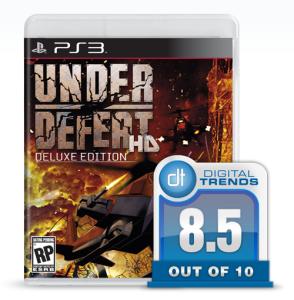 Under Defeat HD creator G.Rev is a hard studio to define. “Video game studio” doesn’t really cover it. Are they revivalists? Not necessarily, since the brand of shooter they make has never truly died. Ever since Namco made Space Invaders more than a generation back, there have been video games where a small airplane, spaceship, or flying person has stayed at the bottom of the screen and shot things at the top. G.Rev is a preservationist then, the studio a team of veritable video game John Muir Historical Society, keeping alive one of the medium’s primordial forms years after its primacy. Playing Under Defeat HD is not unlike exploring an old growth forest, a rare and delightful place that can be more than a little intimidating.
Under Defeat HD creator G.Rev is a hard studio to define. “Video game studio” doesn’t really cover it. Are they revivalists? Not necessarily, since the brand of shooter they make has never truly died. Ever since Namco made Space Invaders more than a generation back, there have been video games where a small airplane, spaceship, or flying person has stayed at the bottom of the screen and shot things at the top. G.Rev is a preservationist then, the studio a team of veritable video game John Muir Historical Society, keeping alive one of the medium’s primordial forms years after its primacy. Playing Under Defeat HD is not unlike exploring an old growth forest, a rare and delightful place that can be more than a little intimidating.
The Old Ways
To clarify for the less historically minded players reading, Under Defeat is what was colloquially called a “shmup” once upon a time. Rather than freely shooting stuff in a three-dimensional space at your own pace, you control a helicopter while trying to avoid bullets while the environment scrolls past automatically. The game’s broken down into ten levels, five in the regular campaign, five remixes that flip enemy placement, and each one has a huge boss waiting at the end, just like in the old days. If a single bullet fired from one of the game’s myriad flying and stationary enemies hits your helicopter, it blows up. You get three lives standard (you can increase the number) and just two continues to start.

Even with its old-school core, Under Defeat does have a novel take on the old formula. Unlike famous shmups like Capcom’s classic 1942, the helicopter you control in Under Defeat can fire at angles rather than just straight forward. If you aren’t shooting the standard machine gun and press right or left, the helicopter will realign in that direction. Pressing fire again will lock the chopper in position. You also have a secondary weapon, a little satellite for your copter that can be fired out when a meter in the corner fills up. The set up makes for some excellent strategic set ups.
Take the third level’s boss, a giant bomber. Its wings are the only vulnerable spot, so to both hit and avoid the incoming fire you can launch out the satellite canon (you can also pick up a canon or target-locking rocket launcher from downed enemies if you prefer) that fires straight ahead while you camp out on the right side of the screen, angled left to hit the wings in safety. Simple tools that make for elegant, complex assaults. If things get hairy, you also have bombs that’ll clear out most enemies, but more importantly, they’ll clear out the bullets cluttering the screen.
Bullet Heaven
Those are your resources in Under Defeat, but reflexes and memory are really your primary tools. The screen fills up with enemy fighters and tanks fast, each one pew pew-ing out bullets in clusters making them hard to avoid, but they’re always in the same spot. Quick decisions will carry you far on the game’s easiest setting, but on Normal you need to learn where enemies pop up and prepare accordingly.
Learning the levels isn’t a burden, though. Part of what’s marginalized shooters in the past decade is a push towards “bullet hell” games like Death Smiles, or cult-favorite studio Treasure’s games like Ikaruga. These games focus on filling the screen with hundreds or even thousands of bullets, and the only way to progress is to memorize where enemies fire. Under Defeat harkens back to arcade games like Raiden, which allow for more improvisations once you’re familiar with where enemies are.

G.Rev’s game pleases the senses as well. The soundtrack is sweet, full of the melodramatic rock style of old shooters, and the 3D graphics seem muted at first, the style proves fitting for the action. The widescreen version in this re-release looks great, while an arcade mode with a narrow screen is included for purists. The physical version of the game comes with a host of extras to enjoy like the soundtrack and an art gallery of the game’s lady pilots.
Conclusion
Under Defeat HD is the last of its kind in many ways. Back in 2006, it was one of the very last commercially released Dreamcast games in Japan. In 2012, it may very well be one of the last shmups ever released on a disc rather than as a download. Even downloadable shmups are built in a different mold than G.Rev’s game. It’s worth checking out to help preserve a piece of gaming’s past, but first and foremost it’s worth playing because it’s very, very good.
Score: 8.5 out of 10
(This game was reviewed on the PlayStation 3 using a copy provided by the publisher.)


